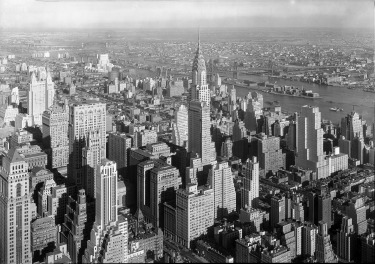During the interwar decades, the transition from rural to urban living affected all aspects of American life: consumerism flourished, nativist tensions flared, technology such as the automobile provided revolutionary mobility, and identity became more fluid. America’s character was significantly influenced by this transition into an industrial, urban, and modern way of life, making the study of the city and its effect on American culture vital to the understanding of American modernism as a whole.
The first section explores the growth of consumerism as a result of this transition into city life. During the early 20th century, consumerism began to change drastically with the new resources for advertisement as well as the increased availability of products. Things like billboard advertisements and shopping centers resulted in an increased focus of American culture on consumption rather than production. The concept of masculinity became directly attached to a dollar sign and a woman’s femininity was associated with her clothing and accessories. While some opponents saw the diffusion of these ideas as harmful to the sanctity of American culture, most saw this refocus on consumption as an economically efficient means of self-expression. Advertisements became more creative and innovative and the accessibility of a wide variety of products made people see their personal shopping choices as a way of differentiating themselves from their neighbor.
The second section is about nativism and the way in which it was present in the urban setting. One of the biggest things about a city is the dynamics between the people who live within it. During the time when Modernism had its reign over the arts, the best way to describe the dynamic between the people were strained at best. The idea of nativism was running rampant through the streets of large cities and cities where immigrants would land in America and causing rifts and strains upon the people who were already there and the newly arrived immigrants. It was these strains that inspired many pieces of literature, music, and theatrical pieces that have been come to part of American Modernism.
The third section focuses on the impact of the automobile in the context of urbanization. The invention of the automobile changed life drastically for Americans from 1914-1945. It allowed people to be more mobile and experience things that used to be far out of reach like cities. The automobile allowed people to leave their towns for a night night out and as a result helped city life to boom. This new form of transportation became a central part of pieces of modernist literature like The Great Gatsby and The Sun Also Rises. Automobiles allowed the plot to move places that it could not have without it. The automobile not only changed Americans lives, it gave authors new opportunities to expand and develop their works.
The fourth section examines the overall impact on identity caused by the setting of the city. In looking at the manner identity was constructed and perceived during the modernist era, it is essential to accent two factors: density and diversity. With the buildings towering and overshadowing the streets, the city appeared to be more closed in and was more crowded due to the transition of populations to the small apartments in cities. With this outlook, it would seem that the individual would be completely devalued, lost within a sea of faces–and it was, to an extent. However, in many city environments social identities began accommodating and making up for this slight loss of identity, especially in the context of the queer and black communities.
